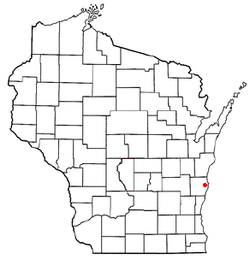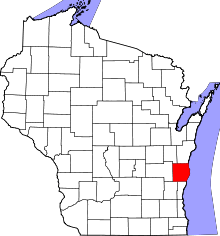Kohler, Wisconsin
| Kohler, Wisconsin | |
|---|---|
| Village | |
 | |
 Location of Kohler, Wisconsin | |
| Coordinates: 43°44′18″N 87°46′52″W / 43.73833°N 87.78111°WCoordinates: 43°44′18″N 87°46′52″W / 43.73833°N 87.78111°W | |
| Country | United States |
| State | Wisconsin |
| County | Sheboygan |
| Area[1] | |
| • Total | 5.63 sq mi (14.58 km2) |
| • Land | 5.41 sq mi (14.01 km2) |
| • Water | 0.22 sq mi (0.57 km2) |
| Elevation[2] | 686 ft (209 m) |
| Population (2010)[3] | |
| • Total | 2,120 |
| • Estimate (2012[4]) | 2,106 |
| • Density | 391.9/sq mi (151.3/km2) |
| Time zone | Central (CST) (UTC-6) |
| • Summer (DST) | CDT (UTC-5) |
| Area code(s) | 920 |
| FIPS code | 55-40275[5] |
| GNIS feature ID | 1567601[2] |
| Website |
www |
Kohler is a village in Sheboygan County, Wisconsin, United States, along the Sheboygan River. The population was 2,120 at the 2010 census. It is included in the Sheboygan, Wisconsin Metropolitan Statistical Area.
History
Originally called Riverside within the rural Town of Sheboygan, the village was founded as a model company town in 1900 when the Kohler Company built a new plant at the location in 1900.[6] The village was incorporated in 1912 as the Village of Kohler. Of the original homes, most built between 1917 and 1931, approximately 95% are owner occupied. The Kohler Company continues to retain final authority over the design of home and business additions, outbuildings and fences in the village to keep them within a certain aesthetic standard.
In 1934, 1954-1965, 1983, and 2015, the United Auto Workers and other unions have struck against the Kohler Company, causing limited to major disruptions to village operations.
Geography
Kohler is located at 43°44′18″N 87°46′52″W / 43.73833°N 87.78111°W (43.738244, -87.781109).[7]
According to the United States Census Bureau, the village has a total area of 5.63 square miles (14.58 km2), of which, 5.41 square miles (14.01 km2) of it is land and 0.22 square miles (0.57 km2) is water.[1]
Demographics
| Historical population | |||
|---|---|---|---|
| Census | Pop. | %± | |
| 1920 | 403 | — | |
| 1930 | 1,748 | 333.7% | |
| 1940 | 1,789 | 2.3% | |
| 1950 | 1,716 | −4.1% | |
| 1960 | 1,524 | −11.2% | |
| 1970 | 1,738 | 14.0% | |
| 1980 | 1,651 | −5.0% | |
| 1990 | 1,817 | 10.1% | |
| 2000 | 1,926 | 6.0% | |
| 2010 | 2,120 | 10.1% | |
| Est. 2015 | 2,110 | [8] | −0.5% |
2010 census

As of the census[3] of 2010, there were 2,120 people, 784 households, and 608 families residing in the village. The population density was 391.9 inhabitants per square mile (151.3/km2). There were 871 housing units at an average density of 161.0 per square mile (62.2/km2). The racial makeup of the village was 96.0% White, 0.2% African American, 2.5% Asian, 0.2% from other races, and 1.1% from two or more races. Hispanic or Latino of any race were 2.3% of the population.
There were 784 households of which 38.6% had children under the age of 18 living with them, 68.9% were married couples living together, 6.6% had a female householder with no husband present, 2.0% had a male householder with no wife present, and 22.4% were non-families. 19.0% of all households were made up of individuals and 9.8% had someone living alone who was 65 years of age or older. The average household size was 2.70 and the average family size was 3.12.
The median age in the village was 42 years. 30.5% of residents were under the age of 18; 3.2% were between the ages of 18 and 24; 22% were from 25 to 44; 29.4% were from 45 to 64; and 15% were 65 years of age or older. The gender makeup of the village was 47.2% male and 52.8% female.
2000 census
| Population | 1926 | 100.00% |
| • White | 1872 | 97.20% |
| • Asian | 37 | 1.92% |
| • Hispanic or Latino | 16 | 0.83% |
| • Two or more races | 10 | 0.52% |
| • African American | 1 | 0.05% |
| • Pacific Islander | 1 | 0.05% |
| • Other races | 5 | 0.26% |
The population density was 354.0 people per square mile (136.7/km²). There were 792 housing units at an average density of 145.6 per square mile (56.2/km²).
There were 568 families and 737 households out of which 38.7% had children under the age of 18 living with them, 71.4% were married couples living together, 3.9% had a female householder with no husband present, and 22.9% were non-families. 21.0% of all households were made up of individuals and 10.3% had someone living alone who was 65 years of age or older. The average household size was 2.61 and the average family size was 3.06.
In the village the population was spread out with 28.8% under the age of 18, 3.3% from 18 to 24, 27.5% from 25 to 44, 27.9% from 45 to 64, and 12.5% who were 65 years of age or older. The median age was 40 years. For every 100 females there were 92.2 males. For every 100 females age 18 and over, there were 93.0 males.
The median income for a household in the village was $75,000, and the median income for a family was $86,123. Males had a median income of $53,839 versus $32,188 for females. The per capita income for the village was $39,355. About 2.6% of families and 2.8% of the population were below the poverty line, including 3.4% of those under age 18 and 3.9% of those age 65 or over.
Businesses
As a company town, the Kohler Company, a leading plumbing and small engine company is the village's largest employer in general. Kohler's hospitality division, containing The American Club and its golf resorts, made up of Blackwolf Run in Kohler and Whistling Straits in nearby Haven (which carries a Kohler postal address), along with Kohler's residential real estate and retail arms make up the largest goods & services employer for the village.
Kohler has two major shopping areas, with the Shops at Woodlake Kohler just north of the village's downtown, and Deer Trace on land on the extreme southeast side of the village along WI 28, with the only connection within the village itself to it along County Highway A along the east side of Blackwolf Run.
Notable people
- Walter Ireland, member of Wisconsin State Assembly and businessman
- David Kohler, president and chief executive officer, Kohler Company
- Herbert Kohler, Jr., industrialist
- Joe Wolf, retired NBA player
References
- 1 2 "US Gazetteer files 2010". United States Census Bureau. Retrieved 2012-11-18.
- 1 2 "US Board on Geographic Names". United States Geological Survey. 2007-10-25. Retrieved 2008-01-31.
- 1 2 "American FactFinder". United States Census Bureau. Retrieved 2012-11-18.
- ↑ "Population Estimates". United States Census Bureau. Retrieved 2013-06-24.
- 1 2 "American FactFinder". United States Census Bureau. Retrieved 2008-01-31.
- ↑ "Kohler Village, * Garden At The Factory Gate,' Ages Gracefully". The Sheboygan Press. 1 Jun 1976. p. 9.
- ↑ "US Gazetteer files: 2010, 2000, and 1990". United States Census Bureau. 2011-02-12. Retrieved 2011-04-23.
- ↑ "Annual Estimates of the Resident Population for Incorporated Places: April 1, 2010 to July 1, 2015". Retrieved July 2, 2016.
- ↑ "Census of Population and Housing". Census.gov. Retrieved June 4, 2015.
